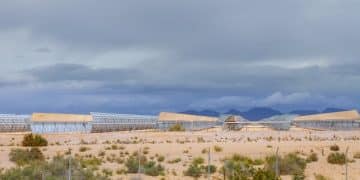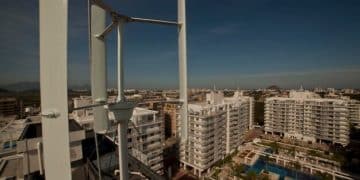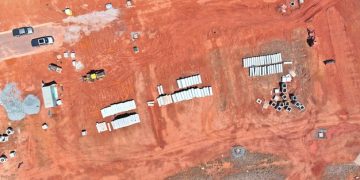Emerging Business Trends: US Renewable Energy Investment

Increased U.S. investment in renewable energy is fostering new business trends, including technological innovation, grid modernization, and the rise of sustainable finance and community-based projects.
The surge in U.S. investment in renewable energy is not just an environmental shift; it’s a catalyst for dynamic business trends. From innovative technologies to evolving financial models, understanding these changes is crucial for businesses and investors alike. Let’s explore what business trends are emerging from the increased US investment in renewable energy.
Renewable Energy Investment Spurs Innovation
The influx of capital into renewable energy has triggered a wave of innovation across various sectors. This innovation is essential for improving efficiency, reducing costs, and enhancing the overall viability of renewable energy sources.
Technological Advancements in Solar Energy
Solar energy is experiencing significant advancements, making it more accessible and efficient.
- Perovskite Solar Cells: These cells offer higher efficiency and lower production costs compared to traditional silicon-based cells.
- Bifacial Solar Panels: These panels capture sunlight from both sides, increasing energy production by up to 30%.
- Floating Solar Farms: These installations on bodies of water reduce land use and improve panel performance by keeping them cooler.
These advancements are driving the adoption of solar energy in both residential and commercial sectors.
Wind Energy Innovations
Wind energy is also benefiting from technological breakthroughs.
- Larger Turbines: Taller and more powerful turbines can capture more wind energy, increasing overall output.
- Offshore Wind Farms: These farms harness stronger and more consistent winds, generating more electricity than land-based turbines.
- Blade Design: Advanced blade designs improve aerodynamic efficiency and reduce noise pollution.
These innovations are making wind energy a more reliable and cost-effective source of power.

In conclusion, the renewable energy sector is experiencing rapid innovation, driven by increased investment and a growing demand for clean energy solutions. These advancements are paving the way for a more sustainable and efficient energy future.
Modernizing the Grid for Renewable Energy Integration
Integrating renewable energy sources into the existing power grid requires significant modernization. This modernization is crucial for ensuring grid stability, reliability, and efficiency.
Smart Grid Technologies
Smart grids are essential for managing the intermittent nature of renewable energy sources.
- Advanced Metering Infrastructure (AMI): These systems provide real-time data on energy consumption, enabling better grid management.
- Smart Inverters: These devices convert DC power from renewable sources to AC power and provide grid support functions.
- Energy Storage Systems: These systems, such as batteries and pumped hydro, store excess energy for later use, helping to balance supply and demand.
These technologies are enhancing the grid’s ability to handle variable renewable energy inputs.
Investing in Transmission Infrastructure
Upgrading transmission infrastructure is vital for delivering renewable energy from remote generation sites to urban centers.
- High-Voltage Direct Current (HVDC) Transmission: These lines transmit electricity over long distances with minimal losses.
- Grid Expansion: Building new transmission lines to connect renewable energy projects to the grid is essential.
- Substation Upgrades: Modernizing substations to handle increased power flows and integrate new technologies is necessary.
These investments in transmission infrastructure are facilitating the widespread adoption of renewable energy.
In summary, modernizing the grid is crucial for integrating renewable energy sources effectively. Investments in smart grid technologies and transmission infrastructure are essential for ensuring a reliable and sustainable energy supply.
Sustainable Finance and Renewable Energy Projects
The rise of sustainable finance is playing a significant role in funding renewable energy projects. Investors are increasingly prioritizing environmental, social, and governance (ESG) factors when making investment decisions.
Green Bonds and Renewable Energy
Green bonds are a popular mechanism for financing renewable energy projects.
- Dedicated Funding: Green bonds are specifically earmarked for environmentally friendly projects, such as solar and wind farms.
- Investor Demand: There is growing demand from investors for green bonds, driven by ESG considerations.
- Transparency and Accountability: Green bonds require issuers to report on the environmental impact of the projects they finance.
Green bonds are providing a reliable source of funding for renewable energy initiatives.
ESG Investing in Renewable Energy
ESG investing is driving capital towards companies that prioritize sustainability.
- Positive Screening: Investors are actively seeking out companies with strong ESG performance.
- Impact Investing: This approach focuses on investments that generate positive social and environmental outcomes, alongside financial returns.
- Shareholder Activism: Investors are using their influence to push companies to adopt more sustainable practices.
ESG investing is fostering a culture of sustainability within the renewable energy sector.

In conclusion, sustainable finance is a key driver of renewable energy investment. Green bonds and ESG investing are providing the capital needed to develop and deploy clean energy technologies.
Community-Based Renewable Energy Initiatives
Community-based renewable energy initiatives are gaining momentum, empowering local communities to participate in the clean energy transition. These projects often involve local ownership and decision-making.
Community Solar Projects
Community solar projects allow multiple households to benefit from a single solar installation.
Community solar projects are revolutionizing access to solar energy, especially for those unable to install panels individually. By creating shared solar facilities, entire communities can benefit collectively. These initiatives usually involve local residents who subscribe to a portion of the solar farm’s output, receiving credits on their electricity bills. Because they encourage community participation and local ownership, community solar projects are not only ecologically sound but also economically beneficial, bolstering regional resilience and lowering energy expenses for every participant.
Local Wind Energy Development
Local wind energy projects can provide communities with a clean and affordable source of electricity.
- Job Creation: These projects create local jobs in manufacturing, installation, and maintenance.
- Economic Benefits: Communities receive lease payments from wind farm operators, boosting local economies.
- Energy Independence: Local wind energy reduces reliance on fossil fuels and imported energy.
These projects empower communities to take control of their energy future.
Government Policies and Incentives
Government policies and incentives play a vital role in stimulating renewable energy investment. These measures can reduce project costs, encourage innovation, and create a level playing field for renewable energy technologies.
Tax Credits and Rebates
Tax credits and rebates are effective tools for promoting renewable energy adoption.
Tax credits and rebates are vital in propelling the adoption of renewable energy technologies. These financial incentives significantly decrease upfront costs, thereby making solar panels, wind turbines, and associated equipment much more financially accessible to both homeowners and businesses. By reducing the initial investment barrier, governments encourage larger adoption rates, which in turn drive up demand and economies of scale. This creates a virtuous cycle, further reducing costs and reinforcing the economic rationale for choosing renewable energy systems.
Renewable Portfolio Standards (RPS)
RPS mandates require utilities to generate a certain percentage of their electricity from renewable sources.
- Guaranteed Demand: RPS ensures a steady demand for renewable energy, encouraging investment in new projects.
- Market Certainty: RPS provides developers with a clear long-term market outlook, reducing investment risk.
- Clean Energy Transition: RPS drives the transition to a cleaner energy mix, reducing greenhouse gas emissions.
RPS policies are accelerating the deployment of renewable energy across the country.
Emerging Business Models in Renewable Energy
New business models are emerging in the renewable energy sector, driven by technological advancements and evolving market dynamics. These models are making renewable energy more accessible, affordable, and reliable.
Power Purchase Agreements (PPAs)
PPAs are long-term contracts between renewable energy developers and electricity consumers.
- Stable Revenue Stream: PPAs provide developers with a guaranteed revenue stream, reducing financial risk.
- Fixed Electricity Prices: Consumers lock in fixed electricity prices, protecting them from volatile fossil fuel prices.
- Renewable Energy Procurement: Companies can meet their sustainability goals by purchasing renewable energy through PPAs.
PPAs are facilitating the growth of renewable energy projects for businesses and utilities.
Energy-as-a-Service (EaaS)
EaaS models provide customers with energy solutions, such as solar and storage, without requiring upfront investment.
- No Upfront Costs: Customers pay for energy services on a subscription basis, eliminating the need for capital expenditures.
- Performance Guarantees: EaaS providers guarantee energy savings and system performance, reducing customer risk.
- Comprehensive Services: EaaS providers handle all aspects of the project, including design, installation, maintenance, and monitoring.
EaaS is making renewable energy more accessible to a wider range of customers.
In conclusion, the renewable energy sector is witnessing the emergence of innovative business models that are driving growth and accessibility. PPAs and EaaS are providing flexible and cost-effective solutions for businesses and consumers to embrace clean energy.
| Key Aspect | Brief Description |
|---|---|
| 💡 Innovation Surge | Advanced solar and wind technologies enhancing efficiency and reducing costs. |
| 🌐 Grid Modernization | Smart grids and infrastructure upgrades for renewable integration. |
| 💰 Sustainable Finance | Green bonds and ESG investing fueling renewable projects. |
| 🏘️ Community Initiatives | Local solar and wind projects empowering communities. |
FAQ
▼
Key drivers include government policies, falling technology costs, and rising demand for clean energy from corporations and consumers concerned about climate change.
▼
Green bonds provide dedicated funding for environmentally friendly projects, attracting investors focused on ESG factors and sustainability in their portfolios.
▼
Community solar projects enable multiple households to benefit from a single solar installation, promoting energy equity and local participation in renewable energy.
▼
EaaS is a business model where customers pay for energy solutions, like solar and storage, on a subscription basis, eliminating upfront investment costs and transferring risk to the provider.
▼
Smart grids use advanced technologies to manage the variability of renewable energy, improving grid stability and efficiency through real-time data and energy storage systems.
Conclusion
The increasing investment in renewable energy in the U.S. is driving significant business trends, including technological innovation, grid modernization, sustainable finance, and community-based initiatives. These trends are creating new opportunities for businesses, investors, and communities to participate in the clean energy transition and build a more sustainable future.





